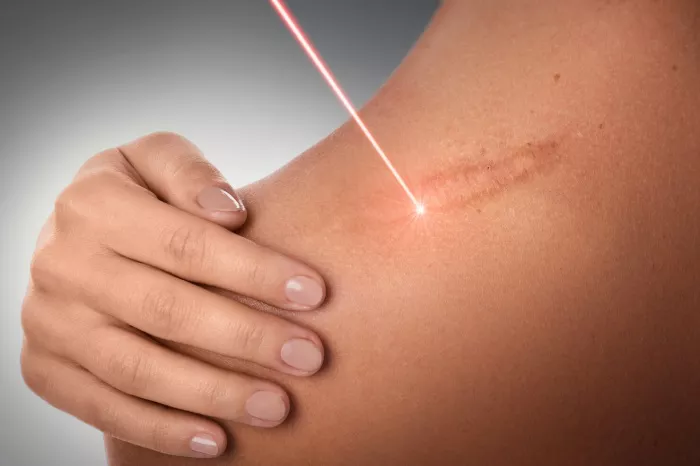Scar revision surgery, also known as scar removal or scar treatment, is a specialized procedure aimed at improving the appearance of scars resulting from injury, surgery, or other causes. While scars are a natural part of the body’s healing process, they can sometimes be aesthetically displeasing or cause functional limitations. Scar revision surgery offers a range of techniques to minimize the visibility of scars and restore skin aesthetics. In this article, we delve into the intricacies of scar revision surgery, exploring its terminology, techniques, benefits, and considerations for patients seeking to enhance the appearance of their skin.
Exploring Scar Revision Techniques
Scar revision surgery encompasses various techniques tailored to address different types of scars and patient needs. Here, we delve into some of the most commonly used techniques:
1. Simple Excision:
Simple excision involves surgically removing the scar tissue and closing the wound with sutures. This technique is suitable for small, well-defined scars that are easily accessible.
2. Z-plasty:
Z-plasty is a surgical technique used to reposition a scar so that it aligns with natural skin creases or lines, making it less noticeable. By altering the direction of the scar, Z-plasty can improve its appearance and reduce tension on the surrounding tissue.
3. Skin Grafting:
Skin grafting involves taking skin from another area of the body, known as the donor site, and transplanting it to cover the scarred area. This technique is useful for large or deep scars where there is insufficient healthy tissue for closure.
4. Flap Surgery:
Flap surgery involves moving healthy skin with its underlying blood supply to cover the scarred area. Flaps may be local, regional, or distant, depending on the location and size of the scar. This technique provides excellent results for complex scars and reconstructive purposes.
5. Laser Resurfacing:
Laser resurfacing is a non-invasive technique that uses laser energy to improve the appearance of scars. By stimulating collagen production and removing damaged skin layers, laser treatments can effectively reduce the visibility of certain types of scars, such as acne scars or fine lines.
Factors Influencing Technique Selection
The choice of scar revision technique depends on various factors, including:
1. Scar Type:
Different types of scars, such as hypertrophic scars, keloids, or atrophic scars, may respond differently to treatment. The surgeon will assess the scar’s characteristics to determine the most appropriate technique.
2. Scar Size and Location:
The size and location of the scar play a crucial role in determining the optimal treatment approach. Scars in highly visible areas, such as the face or hands, may require more meticulous techniques to achieve satisfactory results.
3. Skin Type:
The patient’s skin type and color influence the risk of complications and the choice of surgical technique. Individuals with darker skin tones may be more prone to pigmentary changes or hypertrophic scarring and may require specialized approaches.
4. Patient Preferences:
Patient preferences, goals, and expectations also guide the selection of scar revision techniques. A thorough discussion with the surgeon ensures that the chosen approach aligns with the patient’s aesthetic desires and lifestyle.
Benefits of Scar Revision Surgery
Scar revision surgery offers numerous benefits for patients seeking to improve the appearance of their skin:
1. Improved Appearance:
Scar revision can minimize the visibility of scars, making them less noticeable and enhancing overall skin aesthetics. By employing various surgical techniques, surgeons can reshape, reposition, or remove scar tissue to achieve smoother, more natural-looking results.
2. Functional Improvement:
In cases where scars cause functional limitations, such as restricting movement or impairing facial expressions, scar revision surgery can restore functionality and improve quality of life. Techniques like Z-plasty or flap surgery may be particularly beneficial for addressing functional concerns.
3. Psychological Benefits:
Beyond physical improvements, scar revision surgery can have profound psychological benefits, boosting self-esteem, confidence, and overall well-being. By reducing the visibility of scars, patients often experience greater social confidence and a renewed sense of self-image.
4. Realistic Expectations:
While scar revision surgery can significantly improve the appearance of scars, it is essential for patients to maintain realistic expectations. Complete removal of scars is often not possible, and some degree of residual scarring may remain. However, the goal is to minimize the visibility of scars and enhance skin aesthetics to the greatest extent possible.
Finding a Qualified Surgeon
Selecting a skilled and experienced surgeon is crucial for achieving optimal results in scar revision surgery. Here are some tips for finding a qualified practitioner:
1. Board Certification:
Look for a board-certified plastic surgeon or dermatologist with specialized training and expertise in scar revision surgery. Board certification ensures that the surgeon has met rigorous standards of education, training, and ethical practice.
2. Experience and Reputation:
Research the surgeon’s experience and reputation in performing scar revision procedures. Review before-and-after photos, patient testimonials, and professional affiliations to assess the surgeon’s track record of success.
3. Consultation Process:
Schedule a consultation to discuss your goals, concerns, and treatment options with the surgeon. During the consultation, the surgeon will evaluate your medical history, assess the scar, and recommend the most suitable approach for your unique needs.
4. Communication and Trust:
Choose a surgeon who listens attentively to your concerns, communicates openly and transparently, and establishes a trusting rapport. Effective communication ensures that you are well-informed about the procedure and have realistic expectations about the outcomes.
Preparing for a Consultation
Before your consultation, it’s helpful to prepare by:
1. Gathering Information:
Bring any relevant medical records, previous treatment history, or photos of the scar to the consultation. This information will help the surgeon evaluate your case and recommend appropriate treatment options.
2. Asking Questions:
Prepare a list of questions or concerns to discuss with the surgeon during the consultation. Topics may include the expected outcomes, potential risks and complications, recovery process, and post-operative care instructions.
3. Setting Realistic Goals:
Be honest with yourself about your expectations and goals for scar revision surgery. While the surgeon can offer guidance and recommendations, it’s essential to have realistic expectations about the outcomes and limitations of the procedure.
Recovery and Aftercare
Following scar revision surgery, proper care and attention are crucial for optimal healing and results. Here are some general guidelines for recovery and aftercare:
1. Follow Post-Operative Instructions:
Adhere to the surgeon’s post-operative instructions carefully, including wound care, activity restrictions, and medication management. These instructions are designed to promote healing and minimize the risk of complications.
2. Attend Follow-Up Appointments:
Attend all scheduled follow-up appointments with the surgeon to monitor your progress and ensure that the healing process is proceeding as expected. Your surgeon may recommend additional treatments or adjustments as needed to optimize the results.
3. Protect the Healing Area:
Protect the surgical site from trauma, excessive sun exposure, and other potential sources of injury during the healing process. Follow the surgeon’s recommendations for scar management, including the use of silicone gel sheets or scar creams to promote optimal healing and minimize scarring.
4. Be Patient:
Allow sufficient time for the healing process to unfold and for the final results of scar revision surgery to become apparent. Patience is key, as it may take several months for the scar to mature and for the full benefits of the procedure to manifest.
Conclusion: Embarking on a Journey to Enhanced Skin Aesthetics
Scar revision surgery offers a transformative solution for individuals seeking to improve the appearance of scars and enhance their skin aesthetics. By employing a range of surgical techniques tailored to each patient’s unique needs, skilled surgeons can minimize the visibility of scars, restore functionality, and boost self-confidence. With careful consideration of factors such as scar type, size, location, and patient preferences, scar revision surgery can yield outstanding results and profoundly impact the lives of patients. By selecting a qualified surgeon, preparing for a consultation, and following post-operative instructions diligently, patients can embark on a journey to enhanced skin aesthetics and renewed self-confidence.
Scar revision surgery, also known as scar removal or scar treatment, is a specialized procedure aimed at improving the appearance of scars resulting from injury, surgery, or other causes. While scars are a natural part of the body’s healing process, they can sometimes be aesthetically displeasing or cause functional limitations. Scar revision surgery offers a range of techniques to minimize the visibility of scars and restore skin aesthetics. In this article, we delve into the intricacies of scar revision surgery, exploring its terminology, techniques, benefits, and considerations for patients seeking to enhance the appearance of their skin.
[inline_related_posts title=”You Might Be Interested In” title_align=”left” style=”list” number=”6″ align=”none” ids=”6797,6745,6742″ by=”categories” orderby=”rand” order=”DESC” hide_thumb=”no” thumb_right=”no” views=”no” date=”yes” grid_columns=”2″ post_type=”” tax=””]
































